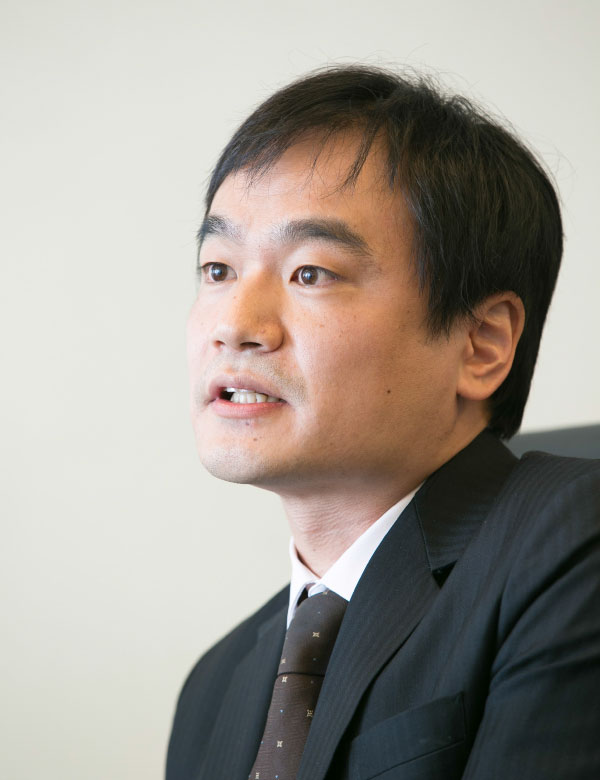Structural reforms and changing patterns in the movement of overseas firms into the Japanese market
Q: Can you describe the current state of the movement of overseas firms into the Japanese market, especially since the start of the Abe Administration?

Toshiya Imai
In the B2B sector, structural reforms and reforms in value chains have created growing opportunities for European and American firms to enter the market in industries where the barriers had been fairly high. For example, an amendment of the Electricity Business Act liberalized the electric power industry. GE of the US subsequently entered the Japanese market in wind power generation, while Landis+Gyr of Switzerland, recently acquired by Toshiba, has done the same in the field of smart meters. It’s conceivable we’ll see the same reforms in fields like mail-order services and related logistics, as well as medicine and medical care.
In addition, it’s possible now for overseas suppliers to enter the Japanese market in the auto parts industry by acquiring Japanese parts makers, taking advantage of the fact that their customers already include the overseas plants of Japanese automakers.
In B2C businesses like food products, daily goods, and cosmetics, the Japanese market involves a large number of players. The competition is fierce, and consumers are demanding. It seems unlikely that overseas firms looking to succeed in the premium segments will significantly change the conventionally adopted strategy as regards entry into the Japanese market, which involves developing products to meet the consumer needs identified here, then deploying these products in other Asian markets.
It may be that the Abe administration is regarded highly overseas not for the merits or demerits of its policies, but for its stability. The largest-ever monetary relaxation measure in April 2013 swelled the monetary supply, tempering the strength of the yen on international currency markets and helping bolster stock prices.
Q: What are some distinguishing characteristics of the Japanese market and its consumers recently?

Shoji Shiraishi
Japan tends to be a market of quality-conscious and discerning consumers willing to pay for quality hospitality and premium features. It’s also a market where meeting high consumer standards generates reliable results.
The overseas automakers that find success in Japan are companies like Mercedes-Benz and BMW, which emphasize a premium feel. Speed limits in Japan are well below 200 km/hour, but plenty of drivers still buy expensive luxury models with powerful engines. It’s not just the wealthy; consumers in the upper middle income brackets consistently demand luxury models, too. That’s why European and American automakers pay very close attention to the reactions of Japanese consumers when introducing new models incorporating the latest technologies.
The same is true for lodging and other industries where hospitality plays a key role. Japanese guests are happy to pay higher prices for accommodations that offer a premium feel, for places whose ambience and amenities alone create special experiences. Over the past decade, spending per guest has trended up at high-end Japanese-style inns. Foreign-affiliated luxury hotels have enjoyed success, too.
The Japanese market remains quality-centric. In this way, it may differ somewhat from the US market, where business models predicated on mass consumption and mass disposal play a central role.
Keys to success in Japan: Setting flexible KPIs and establishing organizational designs appropriate for the scale of a unit
Q: What are some key points overseas firms should keep in mind when moving into the Japanese market?

Tomohiko Kitagawa
Important factors include organizational design and setting appropriate key performance indicators (KPIs).
The successful Japanese subsidiaries of overseas firms take a flexible approach and apply different KPIs for growth and non-growth fields, depending on the maturity of their products or brands. For example, one maker of consumer goods uses rate of growth as a KPI in new and rapidly growing sales channels and profitability as a KPI in existing sales channels where not much future growth is expected.
Important considerations for organizational design include determining a headcount suitable for the functions required and the size of the market and not trying too hard to mimic a Japanese-style organization. Overseas firms with long-standing units in Japan tend to see efficiency decline as they become more like Japanese-style organizations, which tend to depend more on the character and career history of their employees than ability. In contrast, new overseas players in the Japanese market often underestimate the headcounts needed and see their organizations break down as functions and roles concentrate in individual employees.
Q: What positions do Japanese firms or the Japanese subsidiaries of overseas firms occupy within global markets?
Until now, the Japanese market and its demanding consumers have served as a steppingstone to success, a place for training young managers from the company’s home country. Today, the Japanese market also functions as an environment for training young Japanese managers, managers in their early 30s, for companies seeking to advance into emerging markets. Japan accommodates both Western and Asian values, so it’s often seen as a translational interface between the two.
Prime Minister Abe is currently taking the initiative in bringing corporate managers with him when he goes abroad, giving them the opportunity to leverage these trips as sales trips. The companies these managers represent include infrastructure firms that have typically focused on domestic demand. One of Japan's strengths is intellectual property related to expertise in operating an infrastructure and analyzing consumer behavior. If Japan can contribute to economic development in emerging markets in these areas, it can both reap profits and win the respect of people abroad. These days there’s a growing commitment to achieving growth based on steady earnings from overseas business developments. Contributions to the current account balance from repatriation of overseas gains to Japan helps the nation grow.
- Profiles
- Toshiya Imai Representative Director, PwC Strategy& (Japan) Mr. Imai has been active for more than 25 years in strategic development and related areas, including the development of overall strategies, sales and marketing strategies, and global strategy, as well as organizational and cultural reforms at computer makers, IT service providers, and other businesses.
- Shoji Shiraishi Vice President, PwC Strategy& (Japan) For more than 25 years, Mr. Shiraishi has been active in numerous projects involving overall growth strategies, global strategy, and post-merger consolidation in the automotive, industrial machinery, and chemical industries, among others.
- Tomohiko Kitagawa Principal, PwC Strategy& (Japan) Mr. Kitagawa is a consultant on business strategy, sales and marketing strategies, and organizational and operational reforms, among other areas, with a special focus on machinery manufacturing and parts and materials in the industrial goods sector.


